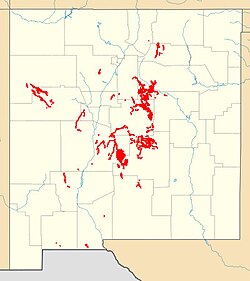Description
The Glorietta Sandstone is a massive yellowish brown to light gray, cliff-forming, fine to medium grained, very mature quartzarenite sandstone that weathers to reddish brown. At the type section, about 33% of the formation is trough-crossbedded sandstone with beds up to 1.3 metres (4.3 feet) thick and with large foresets. Another 27% of the formation is wind-ripple laminated sandstone. Many beds are extremely well cemented. The formation is exposed in most of the flanking uplifts of the Rio Grande Rift and extends in the subsurface to west Texas. It is particularly prominent in Glorieta Pass but extends west to the Jemez Mountains (where it pinches out in the central Nacimiento Mountains) and south to the Socorro area.
The Glorieta Sandstone is of Kungurian (upper Leonardian) age and forms a ledge at or near the top of the Permian section throughout central New Mexico. It rests conformably on the Yeso Group and is overlain either conformably by thin beds of the San Andres Formation or disconformably with Triassic beds. At the type section at Glorieta Pass, is interpreted as a dune field overlain by eolian sheet deposits. Further south, it shows cross stratification suggesting subaqueous deposition, except for local coastal eolian deposition. The presence of forams and herringbone crossbedding also suggests a shallow marine environment.
The Glorieta Sandstone likely correlates with the Coconino Sandstone of Arizona, from which it was separated by the Defiance Uplift. Detrital zircon geochronology suggests that both formations were derived from deflation of an arid transcontinental river system originating in the Appalachian-Ouachita orogen and Canadian Shield with some local sediment sources in the Ancestral Rocky Mountains. However, the Glorieta Sandstone is thinner, with a maximum thickness of less than 90 meters (300 ft) and dune height of 7 meters (23 ft) versus a thickness of 305 meters (1,001 ft) and dune height of 21 meters (69 ft) for the Coconino Sandstone. The Glorieta Sandstone was deposited by trade winds from the northeast while the Coconino Sandstone was deposited by onshore winds from the north and northwest. Tongues of the Glorieta Sandstone are found up to 150 kilometres (93 miles) southward into the San Andres Formation, and marine carbonate beds within the Glorieta Sandstone record repeated northward marine transgressions.
This page is based on this
Wikipedia article Text is available under the
CC BY-SA 4.0 license; additional terms may apply.
Images, videos and audio are available under their respective licenses.



